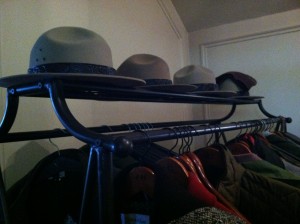
For museum and park enthusiasts, the green and gray uniforms of the National Park Service (NPS) symbolize respect, knowledge, and public service. They’re recognizable and serve as a reminder of the continuing preservation of our national heritage and landscape. But all too often people only associate the NPS with the large outdoor wildlife parks such as Yosemite or the Everglades. What about the battlefields, historic homes, and old ships that are also part of the park system? What about the history?
This question has been a recent topic of interest for the Park Service. In 2012, the NPS Chief Historian’s office and the Organization of American Historians
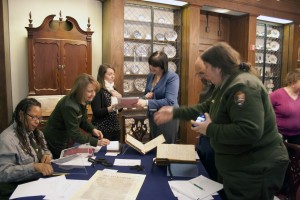
released the results of a multi-year study “examining the practice and presentation of American history in the National Park Service and at its sites” called Imperiled Promise: The State of History in the National Park Service.[1] The report was co-authored by four distinguished public historians: Anne Mitchell Whisnant, Marla R. Miller, Gary B. Nash, and David Thelen. Noting what the NPS gets right, as well as where it could use some improvement, this report is a jumping off point for imagining the future of history in the National Parks.
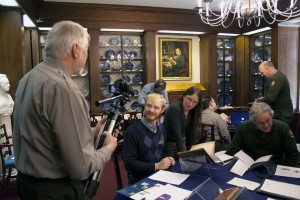 That’s why we were thrilled one day last month when the Goddard-Daniels House and the library were filled with park rangers – green sweaters, badges, hats and all. It was a fantastic group from all over the region, brought together through the efforts of Chuck Arning, Park Ranger and AV Specialist at the Blackstone River Valley National Heritage Corridor and an AAS Council member. The group included representatives from Adams National Historic Site, Boston National Historic Park, Salem National Historic Park, New Bedford Whaling National Historic Park, Lowell National Historic Park, Blackstone River Valley National Heritage Corridor, Minute Man National Historic Park, Springfield Armory National Historic Park, and the Northeast Museum Services Center. Their research interests ranged from abolitionist and anti-slavery activity in Boston, to links between the Caribbean and Salem, to the early development of mills and textiles in the northeast. Not only did the sites cover a wide geography and a variety of topics, but the range of job titles also added to the multiple perspectives offered during the day. These included everything from historian to curator to ranger to archaeologist to superintendent.
That’s why we were thrilled one day last month when the Goddard-Daniels House and the library were filled with park rangers – green sweaters, badges, hats and all. It was a fantastic group from all over the region, brought together through the efforts of Chuck Arning, Park Ranger and AV Specialist at the Blackstone River Valley National Heritage Corridor and an AAS Council member. The group included representatives from Adams National Historic Site, Boston National Historic Park, Salem National Historic Park, New Bedford Whaling National Historic Park, Lowell National Historic Park, Blackstone River Valley National Heritage Corridor, Minute Man National Historic Park, Springfield Armory National Historic Park, and the Northeast Museum Services Center. Their research interests ranged from abolitionist and anti-slavery activity in Boston, to links between the Caribbean and Salem, to the early development of mills and textiles in the northeast. Not only did the sites cover a wide geography and a variety of topics, but the range of job titles also added to the multiple perspectives offered during the day. These included everything from historian to curator to ranger to archaeologist to superintendent.
We began the day in the Goddard-Daniels House with an introduction to AAS and its resources, both those available on campus as well as those accessible from anywhere. After this introduction we headed over to Antiquarian Hall for a workshop with library materials. Prior to their arrival we had invited participants to request items they were interested in seeing, which the AAS staff supplemented with items we believed they would be interested in based on their research topics.
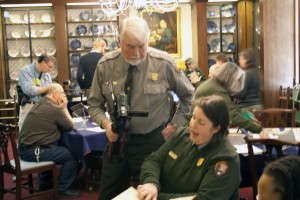
The excitement in the room when the participants made new discoveries was palpable. Take for example the logbook of the ship Tyrannicide. (For a full finding aid of the logbook collection, see here.) When Emily Murphy, historian at Salem National Historic Park, realized what she was looking at, she couldn’t contain her delight. As it turns out, she had been researching this particular ship – a Massachusetts Navy Privateer contracted to be built by Richard Derby, Jr. of Salem, Massachusetts – for years and had had no idea that this logbook even existed. And to make the find even better, the keeper of the logbook was more loquacious than most, giving her entirely new details about life on the ship. This chattiness was due to the fact that the ship’s captain needed to document his movements and actions for the Prize Court and the Massachusetts Naval authorities.
This was not the only item to stir some excitement. For some, it was seeing an original copy of a book they had only read online or in modern reprints. For others, it was a new image of a nineteenth-century shawl shop or a list of items someone lost from their home during the Battles of Lexington and Concord. And for everyone it was more than just the materials, but also the opportunity to share and discuss their research and what they were finding with their colleagues. Many were surprised by how much their own topic related to projects being done at other sites and how helpful it was to have conversations about them. As both a learned society and a library, the combination of research and collegial conversation that characterized the day was just what AAS was hoping to foster, and we were delighted to see it in action.
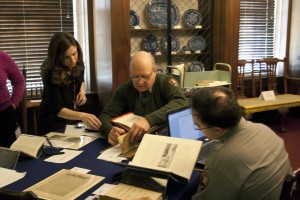
Working with such a knowledgeable and enthusiastic group of park rangers not only made me a bit envious that I don’t have the title “Ranger Kayla” myself, but it also increased my eagerness for AAS to explore more ways to work with and serve the NPS. To begin working towards this goal, the last part of the day was a roundtable discussion brainstorming ideas about how AAS and the NPS can work collaboratively together. The more we talked the more we realized that the possibilities are boundless. AAS’s collections and the NPS’s public history expertise could make a powerful team that would benefit all involved, including the broader public. I, for one, am looking forward to where the future could take us.
[1] “Imperiled Promise: The State of History in the National Park Service,” The Organization of American Historians, http://www.oah.org/programs/nps/imperiled_promise.html.
